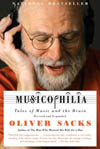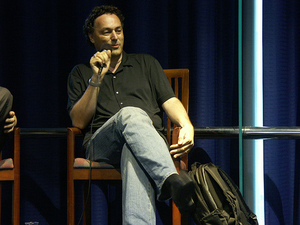
| Welcome to the Club of Amsterdam Journal. Oliver Sacks, physician, author and professor of neurology and psychiatry: “Music can move us to the heights or depths of emotion. It can persuade us to buy something, or remind us of our first date. It can lift us out of depression when nothing else can. It can get us dancing to its beat. But the power of music goes much, much further. Indeed, music occupies more areas of our brain than language does – humans are a musical species.” At our upcoming event on April 29 about the future of Music we are having a dialogue about Music & the Brain, Music & Creative Projects – online and wireless and Music in Games Felix Bopp, editor-in-chief |
Digital Music Report 2010
by IFPI (International Federation of the Phonographic Industry)
“New licensing deals help push digital music sales to 27% of global revenues – but piracy is damaging investment in artists”
- Global digital music trade revenues reach US$4.2 billion, up 12% in 2009
- 400 services licensed worldwide by music companies with ISPs, mobile and other partners
- New figures show local music collapsing in major markets as piracy bites into releases, sales and investment in France, Spain and Brazil
- IFPI Digital Music Report highlights urgent need for legislation to curb digital piracy on ISP networks
More than a quarter of all recorded music industry revenues worldwide are now coming from digital channels, as music companies license music in partnership with ISPs and mobile operators, subscription services, streaming sites and hundreds of download stores.
However, despite the continuing growth of the digital music business – with trade revenues up 12% to an estimated US$4.2 billion in 2009 – illegal file-sharing and other forms of online piracy are eroding investment and sales of local music in major markets.
In particular, three countries known for the historic vibrancy and influence of their music and musicians – Spain, France, Brazil – are suffering acutely, with local artist album sales or the number of releases plummeting.
Governments are gradually moving towards legislation requiring ISPs to curb digital piracy. But progress needs to be much quicker. In 2009, France, South Korea and Taiwan adopted new laws to address the crisis. Other governments, including the UK and New Zealand, have proposed new laws for adoption in 2010.
These are key highlights of the IFPI Digital Music Report, published today. The Report provides an overview of the music industry’s changing business models, outlines the impact of digital piracy internationally, and reviews the efforts of governments to address it.
New models are increasing consumer choice
The Report outlines how music companies are diversifying their revenue streams, offering new ways for consumers to buy and access music. These include: subscription services; music services bundled with devices and broadband subscriptions; streaming services with applications for mobile devices; advertising-supported services that offer premium services; and online music video services.
In the last year, music companies have partnered with advertising-supported services such as Spotify, Deezer, MySpace Music and We7; ISPs such as TDC in Denmark, Terra in Brazil and Sky in the UK; mobile operators such as Vodafone; handset makers such as Nokia and Sony Ericsson; and online video channels such as Hulu and VEVO.
Sales of music downloads, the dominant revenue stream in digital music, are seeing steady growth. Single track download sales increased by an estimated 10%, while digital albums rose an estimated 20% in 2009. Recent innovations in this sector include the introduction of variable pricing, which has increased the conversion of track purchases to album sales, as well as the launch of the iTunes LP and the rollout of DRM-free downloads internationally.
New figures show piracy is harming investment in local talent
Despite this progress, piracy is the major barrier to growth of the legitimate digital music sector and is causing severe damage to local music industries around the world. Providing new evidence of this, three of the world’s biggest music markets, all heavily dependent on local repertoire – France, Spain and Brazil – have seen a sharp slump in the fortunes of their local music industries:
- In Spain, which has one of the highest rates of illegal file-sharing in Europe, sales by local artists in the top 50 have fallen by an estimated 65% between 2004 and 2009;
- France, where a quarter of the internet population downloads illegally, has seen local artist album releases fall by 60% between 2003 and 2009;
- In Brazil, full priced major label local album releases from the five largest music companies in 2008 were down 80% from their 2005 level.
The report shows that, while the music industry has increased its digital revenues by 940% since 2004, piracy has been the major factor behind the overall global market decline of around 30% in the same period. Overall, global music sales in the first half of 2009 were down by 12% (physical and digital sales) and full year figures are likely to see a similar trend.
Third party studies overwhelmingly conclude that the net impact of illegal file-sharing is to depress sales of music. Two surveys confirmed this in 2009 – by Jupiter Research, covering five European countries, and Harris Interactive, covering the UK. According to Jupiter, around one in five internet users in Europe (21%) shares unauthorised music.
“Climate change” for creative industries
The Report also shows how digital piracy is causing “climate change” across the creative industries. In 2009 the issue rose to the top of the agenda for film and TV producers as well as book publishers. TV programme piracy is estimated to be growing faster than in music, according to research firm Big Champagne. Meanwhile, the film industry estimates illegal film streams and downloads account for 40% of its piracy problem by volume (MPAA).
The Report calls for the urgent adoption of laws to curb P2P and other forms of online piracy – including the “graduated response” by which ISPs would cooperate with right holders in deterring illegal file-sharing on their networks.
Introducing the Report, IFPI chairman and CEO John Kennedy, said: “Music fans today can acquire tracks and albums in ways not conceivable a few years ago – from download stores, streaming sites, subscription services, free-to-user sites, bundled with their broadband or a mobile phone handset.
“It would be great to report that these innovations have been rewarded by market growth, more investment in artists, more jobs. Sadly that is not the case. Digital piracy remains a huge barrier to market growth and is causing a steady erosion of investment in local music. The collapse in sales and investment in France, Spain and Brazil, countries with traditionally vibrant music cultures, testify to this and are a warning to the rest of the world.
“In 2009 the mood has crucially changed. It is now accepted that this is about the future of a broad base of creative industries that have huge economic importance and employ vast numbers of people. Governments, led by France, South Korea, Taiwan, the UK and New Zealand led the way in 2009 by adopting or proposing legislation to tackle piracy. It is vital these efforts are seen through to their conclusion and followed by other governments in 2010.”
IFPI (International Federation of the Phonographic Industry) represents the recording industry worldwide with some 1400 members in 66 countries and affiliated industry associations in 45 countries.
Next Event

the future of Music
Thursday, April 29, 2010
Registration: 18:30-19:00, Conference: 19:00-21:15
Location: Hogeschool van Amsterdam, Auditorium, Singelgrachtgebouw, Rhijnspoorplein 1, 1091 GC Amsterdam
The speakers are
Tom Pearce, internationally renowned producer, Owner, Practical Music
Music in Games
Making our own future – Gaming as a promotion and distribution system
Theo Ploeg, lecturer at HvA, journalist, sociologist
Music & Creative Projects – online and wireless
Creativity, music & new media
Aaltje Van Zweden-van Buuren, Founder, The Papageno Foundation & Ria Veldhuizen, Music Therapist, The Papageno Foundation
Music & the Brain
Moments of Musical Meeting, playing with time and expectation.
moderated by GUsta Lebbink, Lebbink Consult
Regenerative Medicine
Regenerative Medicine is the process of creating living, functional tissues to repair or replace tissue or organ function lost due to age, disease, damage, or congenital defects. This field holds the promise of regenerating damaged tissues and organs in the body by stimulating previously irreparable organs to heal themselves. Regenerative medicine also empowers scientists to grow tissues and organs in the laboratory and safely implant them when the body cannot heal itself. Importantly, regenerative medicine has the potential to solve the problem of the shortage of organs available for donation compared to the number of patients that require life-saving organ transplantation, as well as solve the problem of organ transplant rejection, since the organ’s cells will match that of the patient.

Wake Forest Institute for Regenerative Medicine
What may seem like science fiction is happening right here at the Wake Forest Institute for Regenerative Medicine.
From bladder and trachea, to cartilage and heart – we’ve successfully grown more than 20 types of cells in the laboratory. We are an international leader in translating scientific discovery into clinical therapies. Our scientists were the first in the world to successfully implant a laboratory-grown organ into humans and have achieved other world firsts.
In 2006, we reported long-term success implanting bladders that were engineering in the laboratory into young patients with spina bifida
Today, as the bladder technology is being evaluated in patients with spinal cord injuries and in women with severe cases of overactive bladder, we’re working to grow more than 22 other tissues and organs. More than 100 projects are currently underway.
National Taiwan University Hospital, Department of Pediatrics
Beyond liver transplants: Acutely damaged livers may be repaired via transplanted hepatocytes
A research team from the National Taiwan University Hospital has evaluated the efficiency of transplanted hepatocyte (liver) cells in animal models severely damaged by two kinds of chemical toxicity to see whether and how transplanted hepatocytes were able to efficiently repopulate the toxin-induced, severely damaged livers.
The study was carried out in the on-going effort to evaluate hepatocyte transplantation as an alternative to liver transplantation, not only because of the current shortage of liver donors for transplantation, but also because successful cell transplantation is simpler, less invasive and less expensive than organ (i.e., liver) transplantation.
The researchers found that animal model of livers with damage induced from combined retrosine-plus-D-galactosamine (as opposed to animals infused with single toxins) were subject to “massive repopulation of the liver by transplanted hepatocyte cells and hepatocyte growth factor genes.”
“This is an interesting model where massive liver cell death is imposed over a background where the native liver fails to regenerate,” said section editor Dr. Stephen Strom, professor in the Division of Cellular and Molecular Pathology at the University of Pittsburgh. “These are important pre-clinical studies because of the similarities of this model to Acute Liver Failure (ALF) in human patients. The enhanced proliferation of donor cells following transplantation helps to explain why the transplantation of even relatively small numbers of hepatocytes can reverse liver failure.”
CARMAT SAS
In France, there is a new regenerative medicine medical device, the CARMAT heart.
The company has been spun out of a collaboration between the renowned surgeon Professor Carpentier and EADS on implementation of biomaterials and cutting-edge technologies in the construction of an artificial heart. CARMAT intends to market a fully implantable artificial heart that will be able to provide renewed hope and quality of life to the hundreds of thousands of patients suffering in the aftermath of a massive heart attack or with late-stage heart failure and for whom standard drug therapy, ventricular assistance and/or a heart transplant have failed or are not possible.
The new design uses cutting-edge biopolymer materials that promise to reduce the formation of dangerous blood clots – a persistent problem with early artificial hearts – and may even spare patients from needing to use nettlesome anticoagulant drugs. And feedback sensors and software can adjust the heart’s speed and pressure depending on the exertion level of the wearer, permitting a vastly greater range of physical activity.
The preliminary animal trials and lab tests performed with the CARMAT artificial heart have generated interest from the medical community in France and worldwide, as well as from the health authorities. At present, CARMAT’s prototype artificial heart has been patented and is undergoing preclinical testing. It meets the human body’s biocompatibility criteria. It is functionally similar to the human heart in both anatomic and functional terms – notably via automatic regulation of heart rate and blood flow according to the patient’s physiological needs. Following approval by the French Agency for Healthcare Product Safety, CARMAT’s prototype will be evaluated first in life-threatened patients with no other available treatment options and then (depending on the results of the initial clinical trials) in patients with a better prognosis.
Club of Amsterdam blog

Club of Amsterdam blog
http://clubofamsterdam.blogspot.com
March 6: The world needs a new taxation paradigm
March 3: Transformative Thinking
January 8: Mobile Trends 2020
October 6: … Just as Beauty lies in the Eyes of the Beholder … is Wisdom found in the Mind of the Receiver
September 21: Future Connectivity: Healthcare Revolution for Community Development
August 5: Music 3.0 and the rocky pre-media past
News about the Future
 Strata Tower in London generates 8% of its energy needs Strata SE1 is the first development in the world where wind turbines have been integrated within the fabric of the building. The three five bladed nine metre diameter wind turbines are anticipated to produce 50MWh of electricity per year for the landlords supply, approximately 8% of Strata SE1’s estimated total energy consumption. Strata SE1’s sustainable design will reduce carbon emissions for the development and enable Strata SE1’s residents to benefit from lower domestic operating costs, lower service charges, healthier internal environmental conditions and general improvement in their wellbeing. |
 Asia Pacific economic outlook by Deloitte China – In the short-term, China’s outlook is quite good. The lagged effects of aggressive policy in 2009 will render strong growth in 2010. However, China’s success in offsetting the negative impact of the global economic crisis now sets the stage for possible troubles down the road, including risk of inflation, asset price bubbles, excess industrial capacity, and troublesome relations with trading partners. Japan – Following a deep recession in 2009, Japan is now experiencing very slow economic growth combined with deflation. The government’s reaction to the crisis, a combination of monetary and fiscal stimulus, was successful in restoring growth, yet progress remains quite slow compared to other developed economies. Australia – While the overall outlook for Australia is for moderate growth, there are some risks to the forecast, such as the country’s high dependency on global commodity markets and its increasing dependency on China’s economic health. India – India is recovering nicely from a very modest slowdown. This reflects strengthening demand for Indian’s exports as the global economy recovers. In addition, domestic demand is strengthening as business investment accelerates in line with a high level of confidence. Consumer spending is accelerating as well. The result is that the economy is recovering faster than expected. |
Recommended Book

Musicophilia: Tales of Music and the Brain
by Oliver Sacks
Legendary R&B icon Ray Charles claimed that he was “born with music inside me,” and neurologist Oliver Sacks believes Ray may have been right. Musicophilia: Tales of Music and the Brain examines the extreme effects of music on the human brain and how lives can be utterly transformed by the simplest of harmonies. With clinical studies covering the tragic (individuals afflicted by an inability to connect with any melody) and triumphant (Alzheimer’s patients who find order and comfort through music), Sacks provides an erudite look at the notion that humans are truly a “musical species.” — Dave Callanan
Graffiti in South Africa

Drive around Cape Town and you’re bound to spot Faith47’s exceptionally visual and engaging graffiti on a wall somewhere.
Faith47: “I’m from South Africa. [The country] has raised me and given me hidings and heartaches. I’m rooted here but I’m no believer in patriotism. Lines drawn on a map with a pencil are not in sync with nature. Therefore I belong to this world at large. I breathe, in the knowledge that death is certain [and] I am trying to fully catch each breath.”


“Shot over three days in Cape Town while Faith47 put up her work. Quite a heavy place so the video tried to convey what was felt as well as the spirit of the work itself.”
Futurist Portrait: Gerd Leonhard

Gerd Leonhard, Media Futurist
Author & Blogger, Keynote Speaker & StrategistThe Wall Street Journal calls Gerd ‘one of the leading Media Futurists in the World’. He is the co-author of the influential book ‘The Future of Music’ (2005, Berklee Press), as well as the author of ‘Music2.0’ (2008) and the blog-book ‘The End of Control’. Gerd’s background is in music; in 1985 he won the Quincy Jones Award and subsequently graduated from Boston’s Berklee College of Music (1987).
Since 2002, following a decade as digital media entrepreneur and start-up CEO, Gerd travels around the globe and speaks at conferences, events and think-tanks on the Future of Media, Content, Technology, Business, Marketing & Advertising, Branding, Telecom, Communications and Culture.
Gerd is considered a leading expert on topics such as social media, mobile content and mcommerce, innovation and entrepreneurship, UGC and peer production, copyright, licensing and IPR issues, next-generation advertising, marketing and branding, digital content strategies and the development of next-generation business models in the content, communications & technology industries.
Gerd’s keynotes, speeches, presentations and think-tank appearances are renowned for his hard-hitting and provocative yet inspiring and motivational style. With over 300 engagements in 29 countries during the past 7 years, Gerd has addressed over 25.000 executives and professionals, and is considered a key influencer.
His diverse client list includes Nokia, Google, Sony-BMG, Telkom Indonesia, Siemens, Kuoni, RTL, ITV, the BBC, France Telecom / Orange, Deutsche Telekom, The Financial Times, TribalDDB, DDB, Omnicom, the European Commission, Nokia Siemens Networks and many others. Gerd is a member of the Club of Amsterdam Expert group..
Agenda
 | ||
Our Season Program 2009 / 2010: | ||
| April 29, 2010 18:30-21:15 | the future of Music Location: Hogeschool van Amsterdam, Auditorium, Singelgrachtgebouw, Rhijnspoorplein 1, 1091 GC Amsterdam [corner Wibautstraat and Mauritskade]  | |
| June 3, 2010 18:30-21:15 | the future of CERN Location: WTC – World Trade Center, Metropolitan Boardroom of Amsterdam In Business, D tower 12th floor, Strawinskylaan 1, 1077 XW Amsterdam  | |








Customer Reviews
Thanks for submitting your comment!